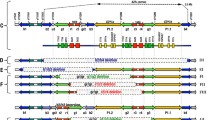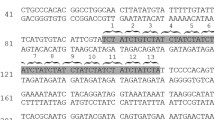Abstract
We have previously reported a high rate of tetranucleotide DNA repeat mutations, including mutations of both germline and somatic origin, in spontaneous human abortions. To analyze in more detail mutational microsatellite (MS) variability in meiosis and its possible association with disturbed embryonic development, we have conducted a comparative study of mutation rates of a panel of 15 autosomal tetranucleotide MSs in 55 families with healthy children and in 103 families that have had spontaneous abortions with normal karyotypes. In the families with miscarriage, the gametic MS mutation rate was higher than in the families with normal reproductive function (4.36 × 10−3 versus 2.32 × 10−3 per locus per gamete per generation), but this difference was statistically nonsignificant (P = 0.25). No association of MS mutations with familiar miscarriage was found. Mutations at the MS loci studied were recorded almost 3 times as often in spermatogenesis as in oogenesis, which is likely to result from a greater number of DNA replication cycles in male germline cell precursors than in female ones. Mutations increasing and reducing the MS sequence length appeared at virtually the same rate. Changes in MS DNA sequence length per one repeated element, i.e., single-step mutations (93% of cases) exceeded all other events of allele length change. The highest number of mutations (81.2%) was found in longer alleles. This distribution of mutations by size, direction, and parental origin corresponds to the multistep mutation model of their emergence via mechanism of DNA strand slippage during replication.
Similar content being viewed by others
REFERENCES
Weber, J.L. and Wong, C., Mutation of Human Tandem Repeats, Hum. Mol. Genet., 1993, vol. 2, pp. 1123–1128.
Brinkmann, B., Klintschar, M., Neuhuber, F., et al., Mutation Rate in Human Microsatellites: Influence of the Structure and Length of the Tandem Repeat, Am. J. Hum. Genet., 1998, vol. 62, pp. 1408–1415.
Xu, X., Peng, M., Fang, Z., and Xu, X., The Direction of Microsatellite Mutations Is Dependent upon Allele Length, Nat. Genet., 2000, vol. 24, pp. 396–399.
Aaltonen, L.A., Peltomaki, P., Leach, F.S., et al., Clues to the Pathogenesis of Familial Colorectal Cancer, Science, 1993, vol. 260, pp. 812–816.
Thibodeau, S.N., Bren, G., and Schaid, D., Microsatellite Instability in Cancer of the Proximal Colon, Lancet, 1993, vol. 260, pp. 816–819.
Spandidos, D.A., Koumantakis, E., Sifakis, S., and Sourvinos, G., Microsatellite Mutations in Spontaneously Aborted Embryos, Fertil. Steril., 1998, vol. 5, pp. 892–895.
Nikitina, T.V. and Nazarenko, S.A., Microsatellite DNA Mutations and Human Embryonic Mortality, Rus. J. Genet., 2000, vol. 36, no.7, pp. 796–801.
Sukhanova, N.N., Lebedev, I.N., Nikitina, T.V., et al., Structure of Chromosome Aberrations in 552 Spontaneously Aborted Embryos in the Tomsk Population, Med. Genet., 2002, vol. 1, no.6, pp. 271–276.
Nikitina, T.V., Lebedev, I.N., Sukhanova, N.N., et al., Maternal Cell Contamination of Cultures of Spontaneous Abortion Fibroblasts: Importance for Cytogenetic Analysis of Embryonic Lethality, Rus. J. Genet., 2004, vol. 40, no.7, pp. 800–809.
Evdokimova, V.N., Nikitina, T.V., Lebedev, I.N., et al., About the Sex Ratio in Connection with Early Embryonic Mortality in Man, Ontogenez, 2000, vol. 31, no.4, pp. 204–210.
Brinkmann, B., Meyer, E., and Jungle, A., Complex Mutational Events at the HumD21S11 Locus, Hum. Genet., 1996, vol. 98, pp. 60–64.
Rolf, D.A. and Bentzen, P., The Statistical Analysis of Mitochondrial DNA Polymorphisms: χ2 and the Problem of Small Samples, Mol. Biol. Evol., 1989, vol. 6, pp. 539–545.
Lakin, G.F., Biometriya. Uchebnoe posobie dlya universitetov i pedagogicheskikh institutov (Biometrics: A Handbook for Universities and Pedagogical Institutions), Moscow: Vysshaya Shkola, 1973.
Leopoldino, A.M. and Pena, S.D., The Mutational Spectrum of Human Autosomal Tetranucleotide Microsatellites, Hum. Mutat., 2003, vol. 21, pp. 71–79.
Nikitina, T.A. and Nazarenko, S.A., Human Microsatellites: Mutation and Evolution, Rus. J. Genet., 2004, vol. 40, no.10, pp. 1065–1079.
Bender, K., Beller, G., and Lautsch, S., Tetranucleotide Short Tandem Repeat Polymorphisms and Their Possible Mode of Origin, Cytogenet. Cell Genet., 1998, vol. 80, pp. 34–36.
Talbot, C.C., Avramoulos, D., Gerken, S., et al., The Tetranucleotide Repeat Polymorphism D21S1245 Demonstrates Hypermutability in Germline and Somatic Cells, Hum. Mol. Genet., 1995, vol. 4, pp. 193–199.
Mahtani, M.M. and Willard, H.F., A Polymorphic X-Linked Tetranucleotide Repeat Locus Displaying a High Rate of New Mutation: Implications for Mechanisms of Mutation at Short Tandem Repeat Loci, Hum. Mol. Genet., 1993, vol. 2, pp. 431–437.
Chakraborty, R., Stivers, D.N., and Zhong, Y., Estimation of Mutation Rates from Parentage Exclusion Data: Applications to STR and VNTR Loci, Mutat. Res., 1996, vol. 354, pp. 41–48.
Kayser, M., Roewer, L., Hedman, M., et al., Characteristic and Frequency of Germline Mutations at Microsatellite Loci from the Human Y Chromosome, As Revealed by Direct Observation in Father/Son Pairs, Am. J. Hum. Genet., 2000, vol. 66, pp. 1580–1588.
Holtkemper, U., Rolf, B., Honoff, C., et al., Mutation Rates at Two Human Y-Chromosomal Microsatellite Loci Using Small Pool PCR Techniques, Hum. Mol. Genet., 2001, vol. 10, pp. 629–633.
Levinson, G. and Gutman, G.A., Slipped Strand Mispairing: A Major Mechanism for DNA Sequence Evolution, Mol. Biol. Evol., 1987, vol. 4, pp. 203–221.
Wierdl, M., Dominska, M., and Petes, T.D., Microsatellite Instability in Yeast: Dependence on the Length of the Microsatellite, Genetics, 1997, vol. 146, pp. 769–779.
Heale, S.M. and Petes, T.D., The Stabilization of Repetitive Tracts of DNA by Variant Repeats Requires a Functional DNA Mismatch Repair System, Cell (Cambridge, Mass.), 1995, vol. 83, pp. 539–545.
Jin, P. and Warren, S.T., Understanding the Molecular Basis of Fragile X Syndrome, Hum. Mol. Genet., 2000, vol. 9, pp. 901–908.
Vogel, F. and Motulsky, A., Human Genetics, Berlin: Springer-Verlag, 1986. Translated under the title Genetika cheloveka, Moscow: Mir, 1989, vol. 2, pp. 172–176.
DiRienzo, A., Peterson, A.C., Garza, J.C., et al., Mutational Processes of Simple-Sequence Repeat Loci in Human Populations, Proc. Natl. Acad. Sci. USA, 1994, vol. 91, pp. 3166–3170.
Amos, W., Sawcer, S.J., Feakes, R.W., and Rubinsztein, D.C., Microsatellites Show Mutational Bias and Heterozygote Instability, Nat. Genet., 1996, vol. 13, pp. 390–391.
Sajantila, A., Lukka, M., and Syvanen, A.-C., Experimentally Observed Germline Mutations at Human Micro-and Minisatellite Loci, Eur. J. Hum. Genet., 1999, vol. 7, pp. 263–266.
Ellegren, H., Heterogeneous Mutation Processes in Human Microsatellite DNA Sequences, Nat. Genet., 2000, vol. 24, pp. 400–402.
Ellegren, H., Microsatellite Mutations in the Germline: Implications for Evolutionary Inference, Trends Genet., 2000, vol. 16, pp. 551–558.
Author information
Authors and Affiliations
Additional information
__________
Translated from Genetika, Vol. 41, No. 7, 2005, pp. 943–953.
Original Russian Text Copyright © 2005 by Nikitina, Lebedev, Sukhanova, Nazarenko.
Rights and permissions
About this article
Cite this article
Nikitina, T.V., Lebedev, I.N., Sukhanova, N.N. et al. Germline Mutations of Tetranucleotide DNA Repeats in Families with Normal Children and Reproductive Pathology. Russ J Genet 41, 770–778 (2005). https://doi.org/10.1007/s11177-005-0159-9
Received:
Issue Date:
DOI: https://doi.org/10.1007/s11177-005-0159-9




